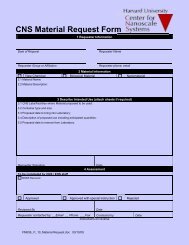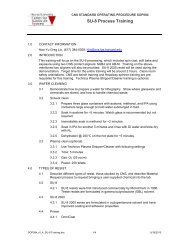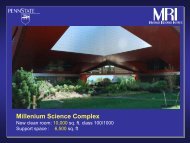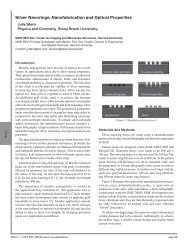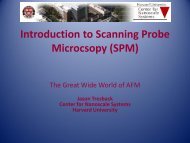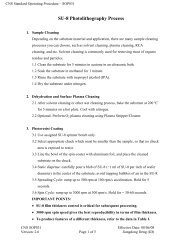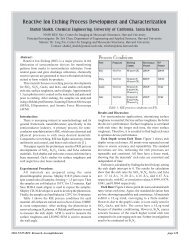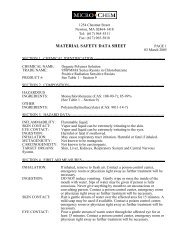BUFFERED OXIDE ETCH 5 to 1 - Center for Nanoscale Systems
BUFFERED OXIDE ETCH 5 to 1 - Center for Nanoscale Systems
BUFFERED OXIDE ETCH 5 to 1 - Center for Nanoscale Systems
- No tags were found...
Create successful ePaper yourself
Turn your PDF publications into a flip-book with our unique Google optimized e-Paper software.
1) Irrigate eyes <strong>for</strong> at least 30 minutes with copious quantities of water, keeping the eyelids apart and away fromeyeballs during irrigation. 2) Get competent medical attention immediately, preferably an eye specialist. 3) If aphysician is not immediately available, apply one or two drops of ophthalmic anesthetic, (e.g., 0.5% Pon<strong>to</strong>caineHydrochloride solution). 4) Do not use oily drops, ointment or HF skin burn treatments. Place ice pack on eyesuntil reaching emergency room.Note <strong>to</strong> Physician:General: For burns of moderate areas, (greater than 8 square inches), ingestion and significant inhalationexposure, severe systemic effects may occur, and admission <strong>to</strong> a critical care unit should be considered. Moni<strong>to</strong>rand correct <strong>for</strong> hypocalcemia, cardiac arrhythmias, hypomagnesemia and hyperkalemia. In some cases renaldialysis may be indicated.Inhalation: Treat as chemical pneumonia. Moni<strong>to</strong>r <strong>for</strong> hypocalcemia, 2.5% calcium gluconate in normal salineby nebulizer or by IPPB with 100% oxygen may decrease pulmonary damage. Bronchodila<strong>to</strong>rs may also beadministered.Skin: For deep skin burns or contact with concentrated HF (over 50%) solution, consider infiltration about theaffected area with 5% calcium gluconate [equal parts of 10% calcium gluconate and sterile saline <strong>for</strong> injection].Burns beneath the nail may require splitting the nail and application of calcium gluconate <strong>to</strong> the exposed nailbed. For certain burns, especially of the digits, use of intra-arterial calcium gluconate may be indicated.Eyes: Irrigation may be facilitated by use of Morgan lens or similar ocular irriga<strong>to</strong>r, using 1% aqueous calciumgluconate solution [50ml of calcium gluconate 10% in 500 ml normal saline].AN ALTERNATIVE FIRST AID PROCEDURE: The effect of HF, i.e. onset of pain, particularly in dilutesolutions, may not be felt <strong>for</strong> up <strong>to</strong> 24 hours. It is important, there<strong>for</strong>e, that persons using HF have immediateaccess <strong>to</strong> an effective antidote even when they are away from their work place in order that first aid treatmentcan be commenced immediately.We recommend that any person in contact with HF should carry, or have access <strong>to</strong> a tube of HF Antidote Gel atall times; ideally with one tube at the work place, one on the person and one at home.It is imperative that any person who has been contaminated by HF should seek medical advice when thetreatment by HF Antidote Gel has been applied.REFERENCES: 1. Browno, T.D. Treatment of Hydrofluoric Acid Burns 2. Sprout, W.L. et al Treatment ofSevere Hydrofluoric Acid Exposures (Journal of American Occupational Medicine 25:12, 1993) 3. Bracken,W.M. et al Comparative Effectiveness of Topical Treatments <strong>for</strong> Hydrofluoric Acid Burns, University ofKansas (Journal of Occupational Medicine 27:10:1985) 4. Burke, W.J. , et al Systemic Fluoride PoisoningResulting from A Fluoride Skin Burn (Journal of Occupational Medicine (5,39:1973)HF ANTIDOTE GEL:Distributed by Pharmascience Inc.8400 Darnley Rd. Montreal, Canada. H4T 1M4Phone: ( 514 ) 340 - 1114Fax: ( 514 ) 342 - 7764U.S. (Buffalo, NY) distribu<strong>to</strong>r: 1-800-207-44775. Fire Fighting MeasuresFire:Not considered <strong>to</strong> be a fire hazard. If involved in a fire, can emit <strong>to</strong>xic fumes and irritating and corrosive gases.





